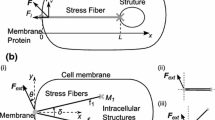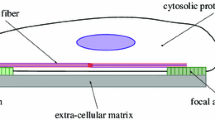Abstract
Cultured vascular endothelial cells undergo significant morphological changes when subjected to sustained fluid shear stress. The cells elongate and align in the direction of applied flow. Accompanying this shape change is a reorganization at the intracellular level. The cytoskeletal actin filaments reorient in the direction of the cells' long axis. How this external stimulus is transmitted to the endothelial cytoskeleton still remains unclear. In this article. we present a theoretical model accounting for the cytoskeletal reorganization under the influence of fluid shear stress. We develop a system of integro-partial-differential equations describing the dynamics of actin filaments, the actin-binding proteins, and the drift of transmembrane proteins due to the fluid shear forces applied on the plasma membrane. Numerical simulations of the equations show that under certain conditions, initially randomly oriented cytoskeletal actin filaments reorient in structures parallel to the externally applied fluid shear forces. Thus, the model suggests a mechanism by which shear forces acting on the cell membrane can be transmitted to the entire cytoskeleton via molecular interactions alone.
Similar content being viewed by others
References
Ando, J. and A. Kamiya 1993. Blood flow and vascular endothelial cell function.Front. Med. Biol. Eng. 5, 245–264.
Burridge, K., G. Nuckolls, C. Otey, F. Pavalko, K. Simon and C. Turner. 1990. Actin-membrane interaction in focal adhesions.Cell Diff. Dev. 32, 337–342.
Civelekoglu, G. and L. Edelstein-Keshet. 1994. Modeling the dynamics of F-actin in the cell.Bull. Math. Biol. 56, 587–616.
Cooper, J. A. 1991. The role of actin polymerization in cell motility.Ann. Rev. Physiol. 53, 585–605.
Davies, P. F. and S. C. Tripathi. 1993. Mechanical stress mechanisms and the cell (an endothelial paradigm).Circ. Res. 72, 239–245.
Dewey, C. F., S. R. Bussolari, M. A. Gimbrone and P. F. Davies. 1981. The dynamic response of vascular endothelial cells to fluid shear stress.J. Biomech. Eng.,103, 177–185.
Doi, M. and S. F. Edwards. 1986.The Theory of Polymer Dynamics. Oxford: Clarendon Press.
Dufort, P. A. and C. J. Lumsden. 1993. Cellular automaton model of the actin cytoskeleton.Cell Motil. Cytoskel. 25, 87–104.
Edelstein-Keshet, L. and G. B. Ermentrout. 1990. Models for contact-mediated pattern formation: cells that form parallel arrays.J. Math. Biol.,29, 33–58.
Franke, R. P., M. Gräfe, H. Schnittler and D. Drenckhahn. 1984. Induction of human vascular endothelial stress fibers by fluid shear stressNature 307, 648–649.
Fry, D. L. 1976. Hemodynamic forces in atherogenesis. InCerebrovascular Diseases, P. Scheinberg (Ed). New York: Raven Press, pp. 77–95.
Geiger, B. 1989. Cytoskeleton-associated cell contacts.Curr. Opin. Cell Biol. 1, 103–109.
Girard, P. R., G. Helmlinger and R. M. Nerem. 1993. Shear stress effects on the morphology and cytomatrix of cultured vascular endothelial cells. InPhysical Forces and the Mammalian Cell, J. A. Frangos (Ed.), San Diego, CA: Academic Press pp.193–222.
Helmlinger, G., R. V. Geiger, S. Schreck and R. M. Nerem. 1991. Effects of pulsatile flow on cultured vascular endothelial cell morphology.J. Biomech. Eng. 113, 123–131.
Ishihara, A. and K. Jacobson. 1993. A closer look at how membrane proteins move.Biophys. J. 65, 1754–1755.
Jammey, P. A., S. Hvidt, J. Käs, A. M. D. Lerche, E. Sackmann, M. Schliwa and T. P. Stossel. 1994. The mechanical properties of actin gel.J. Biol. Chem.,269, 32503–32513.
Käs, J., H. Strey, M. Bärmann and E. Sackmann. 1993. Direct measurement of the wave-vector-dependent bending stiffness of freely flickering actin filaments.Europhys. Lett.,21, 865–870.
Kaufmann, S., J. Käs, W. H. Goldmann, E. Sackmann and G. Isenberg. 1992. Talin anchors and nucleates actin filaments at lipid membranes.FEBS Lett.,314, 203–205.
Ku, D. N., D. P. Giddens, C. K. Zarins and S. Glagov. 1985. Pulsatile flow and atherosclerosis in the human carotid bifurcation.Arteriosclerosis,5, 293–302.
Kusumi, A., Y. Sako and M. Yamamoto. 1993. Confined lateral diffusion of membrane receptors as studied by single particle tracking (nanovid microscopy): effects of calcium-induced differentiation in cultured epithelial cells.Biophys. J. 65, 2021–2040.
Langille, B. L. and S. L. Adamson. 1981. Relationship between blood fow direction and endothelial cell orientation at arterial branch sites in rabbits and mice.Circ. Res.,48, 481–488.
Levesque, M. J. and R. M. Nerem. 1985. The elongation and orientation of cultured endothelial cells in response to shear stress.J. Biomech. Eng. 107, 341–347.
Luby-Phelps, K., D. L. Taylor and F. Lanni. 1986. Probing the structure of cytoplasm.J. Cell Biol. 102, 2015–2022.
Luna, E. J. and A. L. Hitt. 1992. Cytoskeleton-plasma membrane interactions.Science 258, 955–964.
Meyer, R. K. and U. Aebi. 1990. Bundling of actin filaments by alpha-actin depends on its molecular length.J. Cell Biol. 110, 2013–2024.
National Institutes of Health-United States. 1981.Arteriosclerosis 1981. Bethesda, MD: National Heart, Lung and Blood Institute, National Institutes of Health.
Ookawa, K., M. Sato and N. Ohshima 1993. Time course changes in cytoskeletal structures of cultured endothelial cellsFront. Med. Biol. Eng. 5, 121–125.
Otey, C. A., F. M. Pavalko and K. Burridge. 1990. An interaction between alpha-actinin and the β-1-integrin subunit in vitro.J. Cell Biol. 111, 721–729.
Pavalko F. M. and C. A. Otey. 1994. Role of adhesion molecule cytoplasmic domains in mediating interactions with the cytoskeleton.Proceedings of the Society for Experimental Biology & Medicine 205, 282–293.
Pollard, T. D. and J. A. Cooper. 1986. Actin and actin-binding proteins: a critical evaluation of mechanisms and functions.Ann. Rev. Biochem. 55, 987–1035.
Press, W. H., B. P. Flannery, S. A. Teukolsky and W. T. Vetterling. 1987.Numerical Recipes: The Art of Scientific Computing. Cambridge: Cambridge University Press.
Satcher, R. L. 1993. A mechanical model of vascular endothelium. Ph. D. thesis, MIT, Cambridge, MA.
Sherratt, J. A. and J. Lewis, 1993. Stress-induced alignment of actin filaments and the mechanics of cytogel.Bull. Math. Biol. 55, 637–654.
Stossel, T. P., C. Chaponnier, R. M. Ezzell,et al. 1985. Nonmuscle actin-binding proteins.Annu. Rev. Cell Biol. 1, 353–402.
Wang, N., J. P. Butler and D. E. Ingber. 1993. Mechanotransduction across the cell surface and through the cytoskeleton.Science 260, 1124–1127.
Wechezak, A. R., R. F. Viggers and L. R. Sauvage. 1985. Fibronectin and F-actin redistribution in cultured endothelial cells exposed to shear stress.Lab. Invest. 53, 639–647.
Weeds, A. 1982. Actin-bonding proteins: regulators of cell architecture and motility.Nature 296, 811–816.
Wegner, A. 1976. Head to tail polymerization of actin.J. Mol. Biol. 108, 139–150.
Wong, A. J., T. D. Pollard and I. M. Herman. 1983. Actin filament stress fibers in vascular endothelial cells in vivo.Science 167, 867–869.
Zhao, S., A. Suciu, T. Ziegler, J. E. Moore, E. Bürki, J.-J. Meister and H. R. Brunner. 1995. Synergistic effects of fluid shear stress and cyclic circumferential stretch on vascular endothelial cell morphology and cytoskeleton.Arterioscler. Thromb. Vasc. Biol. 15, 1781–1786.
Author information
Authors and Affiliations
Rights and permissions
About this article
Cite this article
Suciu, A., Civelekoglu, G., Tardy, Y. et al. Model for the alignment of actin filaments in endothelial cells subjected to fluid shear stress. Bltn Mathcal Biology 59, 1029–1046 (1997). https://doi.org/10.1007/BF02460100
Received:
Accepted:
Issue Date:
DOI: https://doi.org/10.1007/BF02460100




